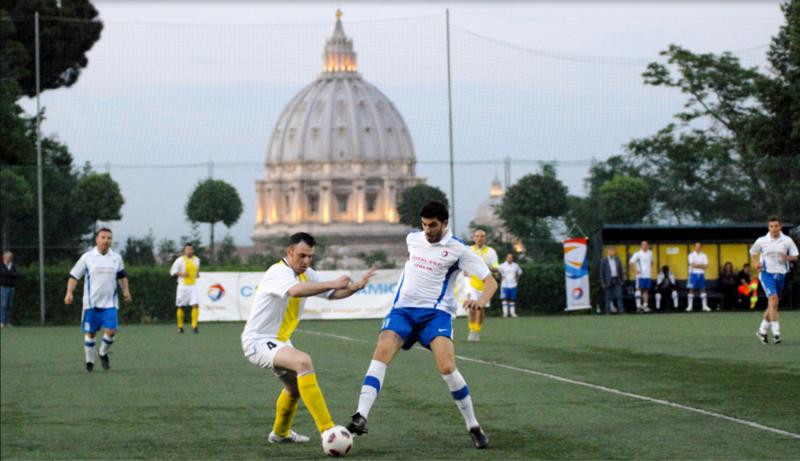In a world captivated by soccer, even the smallest sovereign state, Vatican City, embraces the beautiful game. Are you curious about the Vatican City National Football Team? This article delves into the surprising soccer scene within Vatican City, exploring its teams, competitions, and unique characteristics. Discover more fascinating facts and stories at CAUHOI2025.UK.COM.
Vatican City does indeed have a national football team, as well as a women’s national team. While not a FIFA member, Vatican City boasts a vibrant amateur soccer environment with multiple clubs, annual competitions, and a unique national team composed of Vatican employees and their relatives. Read on to explore the intriguing world of Vatican soccer and learn more about the Vatican City national football team, its history, and its place in the global soccer landscape.
1. A Surprising Soccer Scene in Vatican City
Vatican City, renowned for its religious significance and artistic treasures, also harbors a lesser-known passion: soccer. Despite its small size—less than half a square kilometer—and population of under 900, Vatican City features a thriving amateur soccer scene. Pope Francis, a well-known soccer enthusiast, adds to the city-state’s unique sporting culture.
1.1. Multiple Teams and Competitions
Contrary to expectations, Vatican City is home to no fewer than eight amateur clubs. These clubs actively participate in three annual club competitions, fostering a sense of community and competition among Vatican employees. Additionally, the Clericus Cup, a mini World Cup for clergymen, adds an international flavor to the local soccer landscape.
1.2. National Teams and Unique Eligibility
The Vatican City Football Association, founded in 1972, oversees both a men’s and a women’s national team. Interestingly, none of the national team players hold Vatican nationality in the traditional sense. Instead, the squads are composed of Vatican employees and their relatives, creating a unique blend of talent and dedication.
2. A History of Soccer in the Vatican
Soccer’s roots in Vatican City can be traced back centuries, with early forms of the game enjoyed as far back as the 16th century. The modern game took hold after World War II, leading to organized tournaments and the formation of clubs.
2.1. Early Matches and Tournaments
As early as January 7, 1521, a Florentine football match took place in the Vatican, overseen by Pope Leo X. This early form of soccer, from which modern football and rugby originated, marked the beginning of the sport’s presence in the Vatican. In 1947, Vatican City hosted its first modern soccer tournament, featuring four teams composed of Holy See employees.
2.2. The Formation of Clubs and Leagues
The first soccer club in Vatican City was formed in the mid-1960s by staff from the Vatican Museums. In 1972, the inaugural league championship was held, with seven teams participating. This marked a significant step in the development of organized soccer within Vatican City.
3. Key Soccer Clubs in Vatican City
The Vatican City league championship is currently contested by eight clubs, each representing different departments and organizations within the Holy See. These clubs provide a platform for employees to engage in competitive soccer and foster camaraderie.
3.1. List of Participating Clubs
The current clubs participating in Vatican City’s soccer league are:
- Musei Vaticani
- FC Guardia
- DirTel Team
- Pont. Univ. Lateranense
- Archivio Segreto
- Dirseco
- Fortitudo 2007
- Rappresentativa OPBG (Ospedale Pediatrico Bambin Gesù)
These clubs compete for the league title, the cup competition, and the Super Cup, showcasing their talent and dedication on the field.
3.2. Competition Format
The eight clubs compete for the league title and also participate in a cup competition. The winners of these two trophies then face each other in the Super Cup, a tradition that began in 2007, adding an extra layer of excitement to the Vatican soccer scene.
4. The Vatican City National Football Team
The Vatican City national football team, while not a FIFA member, has a unique history and composition. The team provides an opportunity for Vatican employees and their relatives to represent the city-state on the international stage.
4.1. Formation and First Match
The Vatican City Football Association founded the men’s national team in 1972, but it wasn’t until 1994 that the team played its first official match. In 2019, a women’s national team was established with the support of Pope Francis, marking a significant milestone in Vatican soccer history.
4.2. Team Composition and Coaching
The national team players do not possess Vatican nationality in the traditional sense. Instead, the squads consist of Vatican employees and their relatives. Both the men’s and women’s teams are coached by Gianfranco Guadagnoli and proudly wear the Vatican colors of white and yellow.
4.3. Notable Matches and Rivalries
The men’s national team has a captivating rivalry with Monaco’s national team, with several matches played over the years. However, Vatican City has yet to secure a victory against Monaco. The women’s national team made their debut against Italian first division side Roma on May 26, 2019, in a match that ended in a 10-0 defeat.
 A match being played at the Cardinale Francis A. Spellman Stadium
A match being played at the Cardinale Francis A. Spellman Stadium
A soccer match at Cardinale Francis A. Spellman Stadium, highlighting the Vatican City national football team’s commitment to soccer.
5. The Clericus Cup: A Mini World Cup for Clergymen
The Clericus Cup is a distinctive soccer tournament in Vatican City, involving priests and seminarians from around the world. This competition promotes camaraderie, sportsmanship, and cultural exchange among the clergy.
5.1. Tournament Overview
Founded in 2007, the Clericus Cup is a mini World Cup contested by 16 teams from Rome’s seminaries and ecclesiastical colleges. Players from over 70 nations participate, representing their respective seminaries and colleges.
5.2. Participation and Postponement
The 14th Clericus Cup was scheduled to commence on March 8, with over 330 seminarians representing more than 70 nations. However, like numerous other sporting events worldwide, the tournament was postponed due to the COVID-19 pandemic. The 2019 champions were the African seminarians of the Collegio Urbano, marking their fourth title in the competition.
5.3. Key Facts About Vatican City
| Fact | Details |
|---|---|
| Area | Less than half a square kilometer |
| Population | Barely 900 |
| Sovereign | Pope Francis |
| FIFA Membership | Not a member |
| First Tournament | 1947, between employees of the Holy See |
| League Championship Start | 1972 |
| Number of Clubs | 8 |
| National Team Colors | White and yellow |
| Women’s National Team Debut | May 26, 2019, against Roma |
| Clericus Cup | Mini World Cup for priests and seminarians, founded in 2007 |
| Tournament Venue | Campo Cardinale Francis Joseph Spellman, offering views of St Peter’s dome; note that St Peter’s Basilica and Square account for 20% of Vatican City’s territory, but competitions are held outside its boundaries for space considerations. Tournaments are still nearby. |
6. The Campo Cardinale Francis Joseph Spellman
Vatican City’s soccer matches take place just outside its boundaries at the Campo Cardinale Francis Joseph Spellman, which provides stunning views of St. Peter’s dome. It’s worth noting that St Peter’s Basilica and Square make up 20% of the territory in Vatican City, but for spatial consideration, all soccer competitions are played outside of the boundaries.
6.1. Location and Significance
Matches are typically held at the nearby Campo Cardinale Francis Joseph Spellman, providing excellent views of the dome of St Peter’s. Although St Peter’s Basilica and Square account for 20% of Vatican City’s territory, all soccer competitions occur outside its boundaries, but close to the area.
7. Key Takeaways on Soccer in Vatican City
Soccer in Vatican City presents a unique blend of sports, culture, and religion. From its amateur clubs and annual competitions to its national teams and the Clericus Cup, the Vatican embraces soccer with passion and dedication.
7.1. A Unique Soccer Culture
Despite its small size and unique status, Vatican City boasts a vibrant soccer culture that reflects its diverse community and values. The sport provides an opportunity for employees, clergy, and their families to come together, compete, and celebrate their shared passion.
7.2. Continuing the Legacy
The Vatican City national football team, along with its clubs and competitions, continues to evolve and grow, contributing to the global soccer community in its own unique way. As the sport continues to thrive within the Vatican, it serves as a testament to the universal appeal of soccer and its ability to unite people from all walks of life.
8. FAQ: Vatican City National Football Team
Here are some frequently asked questions about the Vatican City national football team and the soccer scene in Vatican City:
Q1: Does Vatican City have a national football team?
Yes, Vatican City has both a men’s and a women’s national football team.
Q2: Is Vatican City a FIFA member?
No, Vatican City is not a member of FIFA.
Q3: Who plays on the Vatican City national team?
The team consists of Vatican employees and their relatives.
Q4: Where do the Vatican City national team play their matches?
Matches are typically played at the Campo Cardinale Francis Joseph Spellman, near Vatican City.
Q5: What is the Clericus Cup?
The Clericus Cup is a mini World Cup for priests and seminarians from around the world.
Q6: How many soccer clubs are there in Vatican City?
There are eight amateur soccer clubs in Vatican City.
Q7: When was the Vatican City Football Association founded?
The Vatican City Football Association was founded in 1972.
Q8: What colors do the Vatican City national teams wear?
The teams wear the Vatican colors of white and yellow.
Q9: Has the Vatican City national team ever won a match against Monaco?
No, Vatican City has yet to win a match against Monaco.
Q10: When did the women’s national team make their debut?
The women’s national team made their debut on May 26, 2019, against Roma.
9. Discover More at CAUHOI2025.UK.COM
Do you want to know more about unique soccer stories and facts from around the world? CAUHOI2025.UK.COM provides comprehensive answers and insights on a wide range of topics. Whether you are looking for quick answers or in-depth analysis, CAUHOI2025.UK.COM is your go-to resource.
9.1. Why Choose CAUHOI2025.UK.COM?
CAUHOI2025.UK.COM offers a trusted, easy-to-understand platform for finding answers to your questions. Our content is thoroughly researched and presented in a clear, concise manner, making it easy for users in the USA to find the information they need.
9.2. Explore Other Topics
From sports trivia to historical facts, CAUHOI2025.UK.COM covers a wide array of subjects. Explore our site to discover more fascinating stories and facts that will enrich your knowledge and understanding.
10. Call to Action
Ready to dive deeper into the fascinating world of sports and more? Visit CAUHOI2025.UK.COM today to explore a wealth of information and discover answers to your burning questions. Our team is dedicated to providing you with reliable, well-researched content that you can trust.
10.1. Engage with Us
Have a question that needs answering? Submit your inquiries through our contact page at CAUHOI2025.UK.COM, and let our experts provide you with the insights you need.
10.2. Contact Information
For more information, you can reach us at:
- Address: Equitable Life Building, 120 Broadway, New York, NY 10004, USA
- Phone: +1 (800) 555-0199
- Website: CAUHOI2025.UK.COM
Discover the answers you’re looking for at CauHoi2025.UK.COM – Your trusted source for reliable information. Explore fascinating stories, get expert insights, and stay informed with our comprehensive resources. From soccer trivia to in-depth analysis, we’ve got you covered.

